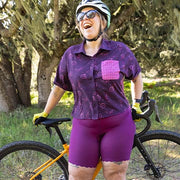I think we can all agree that there’s nothing that comes close to hitting the trails in the Great Outdoors.
But, what do you do when the Great Outdoors aren’t available for some reason? Maybe there’s 6 feet of snow on the ground and a blizzard raging. Maybe your only opportunity to go out riding is in the dead of night. Maybe you have to stay in and wait for UPS to deliver a parcel. Maybe there’s a lockdown in place as a result of a global pandemic. Who knows, but we’re living in strange times and anything can happen that keeps you inside and off the trails.
So, what options do you have if you’re grounded? Well, one thing worth considering to keep your fitness levels up (and your sanity!) is indoor cycling.
Ben Jones from BicycleVolt https://bicyclevolt.com/ (who has been grounded by his parents since 1992) takes a look at the details.
What is indoor cycling?
Ok, so what is this indoor cycling thing? Well, all it is is cycling in your home, or garage, on a stationary bike. You can either do it by bringing your own bike inside, strapping it onto one of a few types of a dedicated bike stand and pedaling away. Or, you can have a special stationary bike, either upright or recumbent, that stays inside all the time.
Why would you do it? What are the benefits?
There have been a few times in my life when I haven’t been able to cycle for a while. When things like injuries, work, and ‘life’ got in the way of getting out on my bike. When that happened, I started noticing my strength and stamina plummeting fast and I became really grumpy (like really, really grumpy). Indoor cycling allows you to keep up (most) of your bike fitness and, quite possibly, make you a nicer person to be around. Your friends and family will thank you.
Pedaling on a stationary bike can also be useful as part of a rehab program if you’re recovering from injury. You might not be ready to hit the trails yet (or your physician might not be ready for you to do that!) but it allows you to build your muscles back up in a safe way. Maybe you don’t have it in you to do a full day out in the mountains yet. But you can start gradually by using a stationary bike. That way it’s easy to do, say, 30 minutes a day this week, then an hour a day next week, and so on. Heading to the trails for only a half-hour would be frustrating, so just hop on the exercise bike instead and bide your time.
Having a bike set up like this at home is useful for when you haven’t got a solid block of time available. Maybe the kids are watching the TV. Maybe you can combine it with a catch-up call with your mom. Either way, it’s an opportunity to get pedaling.
Where can you do it?
The good news about indoor cycling is that you don’t need much space to do it.
Because you’re not moving, you only really need an area that covers a broad rectangle for your bike to sit on. Even less if you’re using an exercise bike. Peloton bikes, for example, only need floor space of around 2’x4’.
Look around your home and the chances are that you’ll find a few places that fit the bill. It might be a corner of your bedroom. Or an unused space in the home office (that you never use anyway). One pro tip is to take your indoor cycling outdoors. I know this sounds silly, but maybe you’ve got a covered porch or canopy that would work. It can be a real benefit as indoor cycling can be a hot and sweaty business without the breeze that you create by cruising along the trails.
What do you need?
The easiest option for indoor cycling is to use a dedicated exercise bike. It’s also the most expensive route, but it does mean you can keep your MTB for the outdoors and do your indoor cycling on the stationary bike. This has become big business in recent years and there are brands like Peloton and Echelon that offer exercise bikes with integrated screens that stream live workout classes 24/7.
They’re not cheap though. A Peloton bike will set you back around $2245 and on top of that, you pay a monthly subscription of up to $39 for the live-streamed classes. Peloton fans are, however, some of the most fanatical I’ve ever met. Almost on a level with MTBers…
The next option is to go with a more basic exercise bike. Look out for brands like Nordictrack and Assault and expect to pay anywhere from $250 to $1250 depending on the build quality and fancy extras that it comes with. These bikes won’t have the high-octane, fist-pumping workouts streamed to a screen in front of you. But you can always look out the window at the Great Outdoors and listen to the birds and squirrels.
What if you want to use your own bike? This has some advantages in that (1) you obviously don’t need to shell out for a second, stationary, one, and (2) it’ll be set up just right for you and won’t need any adjusting.
In that case, there are a couple of different options available: turbo trainers and rollers.
The main differences between the two are:
Turbo trainers hold your bike upright, usually by attaching to the hub of your rear wheel. They can provide resistance as well and this will make it harder to pedal and therefore make you work more.
Rollers, on the other hand, are three rolling cylinders attached to a frame that you put on the floor. They don’t normally offer any resistance as you pedal.
With both types, you’ll generally be best swapping out your tires (or having spare wheels handy). Having a smoother set of tires will give you much less vibration and you only need a cheap set for indoor use.
Turbo trainers are the type that is most used (especially by roadies). But, to be honest, I’m more of a fan of rollers.
Both of them have pros and cons. Turbo trainers are easy to set up and easy to balance on. Plus they integrate more easily with popular apps like Zwift and Trainerroad because of the variable resistance. You can get a basic trainer for between $150 to $450.
I prefer rollers though. On the face of it, you’d think they were a disaster waiting to happen. Balancing a bike when you’re pedaling takes some effort and concentration (as my scraped elbows and knees know to their cost). So, trying to do that in your lounge on three spinning cylinders sounds pretty tough.
And it is. But that’s the point.
Turbo trainers work your leg muscles, but not much else. Rollers on the other hand, because you have to work to keep your balance, give you much more of a full-body workout. For MTBers this is essential as trail riding demands effort from all your muscles. Legs, core, arms, and everything else in between.
In the early days, you can make balancing easier by parking your bike/roller combo inside a sturdy door frame. That can give you something to prop yourself against (or bounce off). Don’t worry though. It only takes a few goes before you’ll get your ‘sealegs’.
Rollers are also the most cost-effective piece of equipment for indoor cycling. You can pick up a good quality set for $100-$200.
Conclusion
I know, I know, biking outside is waaay better than inside. But, if you’ve got no option but to stay indoors, then it’s worth taking a closer look at indoor cycling. It’s a great way of keeping your bike fitness up so that, when you’re released into the wild again, you can hit the ground running.
Or, you know, cycling.
Have fun indoors or out,
Ben






